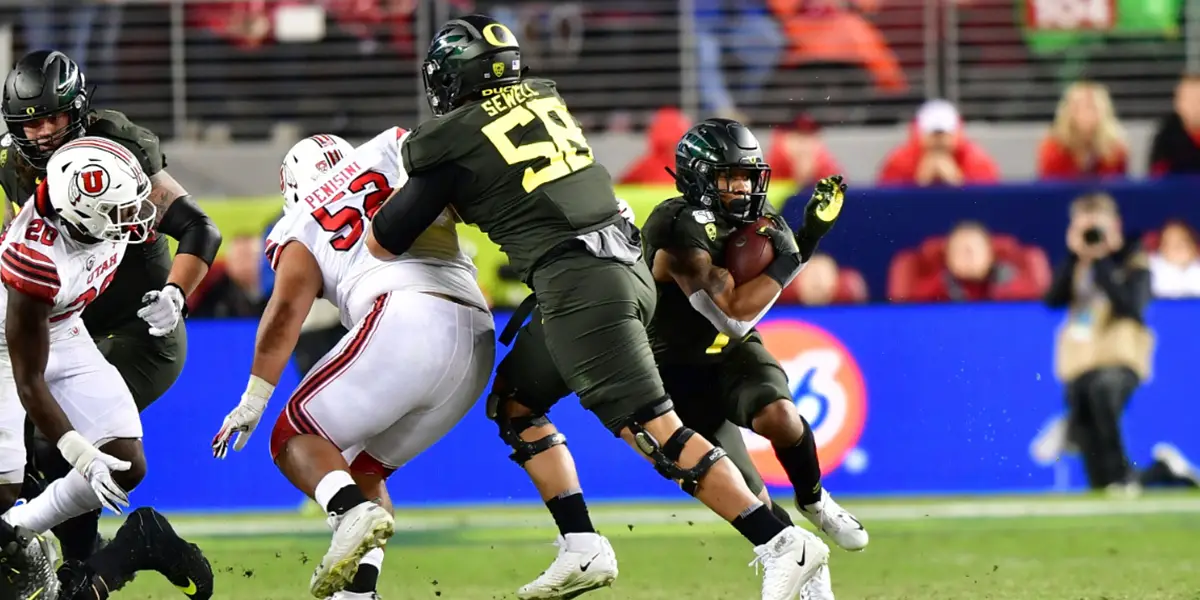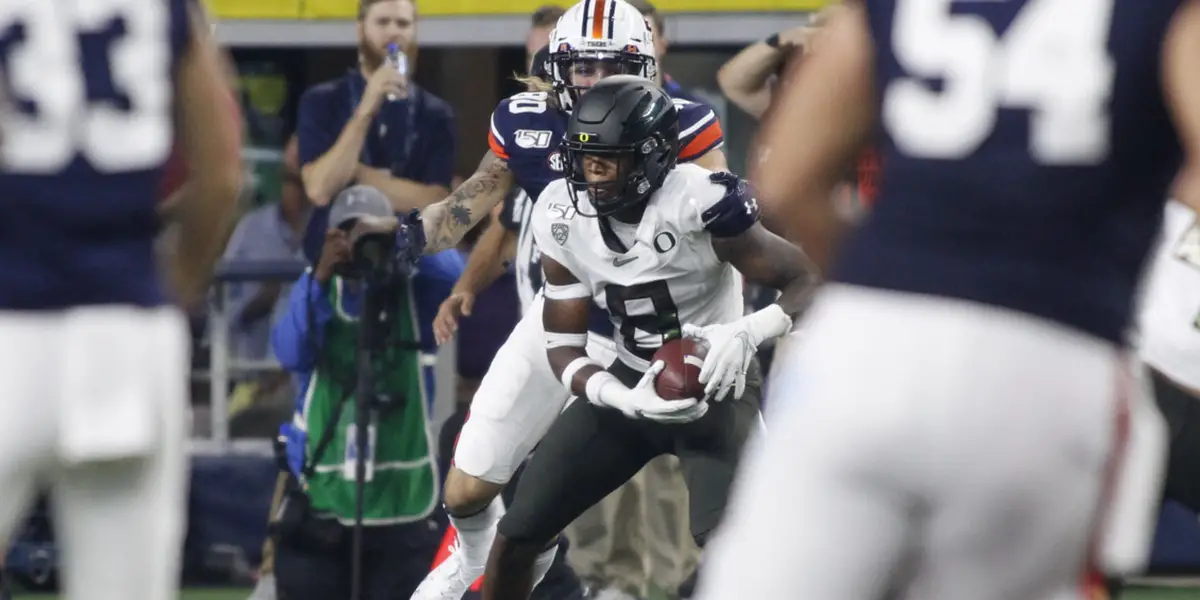For many, this past weekend’s NFL Draft served as a much-needed symbol of hope, as NFL teams across the country celebrated the addition of numerous collegiate superstars. But for the Oregon Ducks, the weekend was bittersweet, as a handful of their most talented players, including four-year starters Justin Herbert and Troy Dye, officially moved on to the next level. Now, the Oregon coaching staff has the unenviable task of replacing their stellar production.
Luckily, the cupboard is far from bare. As much as it hurts to lose such special players, Mario Cristobal and his staff have recruited and developed talent well enough that the Ducks have plenty of skilled players on the 2020 roster, including a deep group of 2021 NFL Draft prospects. With many not yet ready to close the door on draft season, here’s a way-too-early power ranking of Oregon’s top 2021 NFL Draft prospects.
1. Left Tackle Penei Sewell
In the eyes of NFL general managers, offensive tackles are arguably the most second-most important position in football, next to quarterback. The 2020 NFL Draft confirmed this widely held belief, as more tackles were drafted in the first 15 picks than any other position. With quarterbacks being so critical to a team’s offensive success, keeping them healthy and protected is a priority, thus the emphasis on elite tackles.

Sewell (No. 58) clears a gaping hole for his running back.
The 2021 offensive tackle class can be broken down into two tiers. The first tier is Penei Sewell. The second tier is everyone else.
Sewell is far and away the best offensive tackle prospect in the 2021 class, and he’s one of the best offensive tackle prospects in recent memory. He would have been the first offensive tackle off the board in this year’s draft had he been eligible, but instead, he’ll have to spend another year steamrolling defensive ends on Saturdays.
Sewell finished as the nation’s highest-graded offensive player in 2019, according to Pro Football Focus, boasting the top run-blocking grade in the country and an elite pass-blocking grade, to boot. An otherworldly combination of size, power and athleticism, Sewell is the rare prospect that matches elite talent with stellar technique. And at 6’6”, 330 lbs., he has the prototypical size to be a blindside blocker in the NFL.
Simply put, Sewell is the definition of a blue-chip prospect. Early 2021 NFL Draft big boards have him as the top non-quarterback prospect, and if it weren’t for quarterbacks Justin Fields and Trevor Lawrence being the presumptive first- and second-overall picks, Sewell would be in serious contention for the very first pick of the 2021 NFL Draft.
But he’ll have to “settle” for being a lock to go in the top five.
Draft Projection: Top Five
2. Safety Jevon Holland
Jevon Holland is the perfect modern-day safety. Nowadays, there are two types of defensive backs that NFL teams prioritize. The first is a traditional lockdown cornerback who can play “on an island” and shadow an opposing offense’s top receiver. The second is a versatile athlete who can fulfill a variety of roles, including covering the deep third of the field in a cover-3 or cover-1 defense, coming down to the box and playing underneath zone coverage, and matching up against slot receivers, tight ends and running backs in man coverage.

Holland makes an interception against Auburn.
Holland fits the latter description to a tee. He’s not exactly a shutdown, man-to-man cornerback, but he’s a super versatile, ball-hawking athlete who can wreak havoc between the numbers. Holland has experience playing as a nickelback and a deep free safety during his time at Oregon, and he has excelled in both roles, demonstrating the range to drop back into deep zone coverage and the quickness and the instincts to thrive underneath.
To top it off, Holland’s ball skills are special; he’s a natural playmaker who always happens to be around the ball. His nine interceptions in two seasons are more than most players have in their entire careers. Pro Football Focus ranks Holland as the second-best returning defensive back in all of college football in 2020, with the best two-year slot-coverage grade in the country.
Draftsite.com projects Holland as a second-round player, and that looks to be his ceiling. As with most defensive back prospects, his draft positioning will largely depend on how well he tests athletically. He ran an unimpressive 4.7-second laser-timed 40-yard dash as a recruit, but he should improve upon that number with proper training, as he appears to be much faster on film, although still not a burner. If Holland runs in the low 4.5-second range, he should easily be a second-round pick; his skill set is tailor-made for today’s NFL. Otherwise, he’ll be a steal in the third round.
Draft Projection: Second Round or Early Third Round
3. Running Back CJ Verdell
Predicting when CJ Verdell will be drafted is an enigma. It’s hard to determine just how highly some teams value the running back position in the NFL. The modern school of thought is that the position isn’t as valuable as it once was. But on the other hand, it’s clear that some NFL teams still value elite running backs. The defending champion Kansas City Chiefs spent a first-round pick on running back Clyde Edwards-Helaire in the 2020 NFL Draft, after all.

Verdell races past the Washington State defenders.
Verdell isn’t on the same level as Edwards-Helaire as a prospect, and he has some talented counterparts entering the 2021 draft (Travis Etienne, Chuba Hubbard and Najee Harris are all potential first-round prospects). But he’s plenty talented himself, and if a willing, running back-needy team misses out on the aforementioned tailbacks, Verdell could hear his name called relatively early.
Verdell has the one thing that can’t be coached and is always in short supply: speed. Possessing enough wheels to rip off explosive runs and ridiculous acceleration to dart through holes, Verdell has the perfect profile of a one-cut NFL running back. He has enough size to avoid being labeled a third-down back exclusively, and he’s a quality receiver, which is coveted now more than ever at the position.
Verdell isn’t a generational talent at running back, but he’s a highly capable player who’s ideally suited for today’s NFL. The draft positioning of a running back is hard to predict, but if Verdell declares for the draft, he’ll likely be off the board by the end of day two.
Draft Projection: Round Three
4. Cornerback Deommodore Lenoir
The Ducks are loaded in the secondary in 2020, largely because their best NFL prospect at cornerback, Deommodore Lenoir, made the somewhat surprising decision to return to school for his senior season. It’s a decision that should benefit both parties, as Lenoir likely wouldn’t have been a terribly high selection in the 2020 NFL Draft.

Lenoir decided to return to Oregon for his senior season.
Cornerbacks are one of the most “trait-based” positions in the NFL, and the prospects who get drafted early at the position generally fit a certain, elite physical profile. Height, length and speed are the three things almost every evaluator champions above the rest when it comes to scouting cornerbacks, and for good reason. It’s very hard to succeed as a small, unathletic cornerback in the NFL, especially on the outside.
Lenoir checks off one of the boxes, as he’s a very good, fluid athlete. He ran a 4.43-second 40-yard dash as a recruit, which is plenty fast enough to thrive in the pros. And he’s an easy mover with light feet, showing plenty of mirroring ability.
But his size, or lack thereof, could be a significant detriment to his draft stock. Listed at a potentially exaggerated 5’11”, Lenoir is on the low end of desired height at the position, and although there are no official measurements for his wingspan, his poor performance in press coverage (barely ranking in the 25th percentile in this department, per Pro Football Focus) suggests that he could get bullied on the perimeter in the NFL.
For this reason, many are going to pigeonhole Lenoir as a slot defender at the next level. That’s a perfectly fine role for him, as Lenoir has proven to be a very willing run defender and an excellent tackler (skills that are necessary to be productive in the slot), but it will cause him to fall in the draft, as slot defenders aren’t drafted nearly as highly as outside cornerbacks.
Lenoir would have to test exceptionally well athletically for scouts to set aside concerns about his size and play strength. He has been a very good college player, but he’s likely a notch below the top cornerback prospects in the draft class.
Draft Projection: Round Three or Four
5. Cornerback Thomas Graham Jr.
The final draft-eligible member of Oregon’s star-studded defensive backfield is Thomas Graham Jr. Graham is the most experienced of the trio, showing incredible improvement over the course of his career. His freshman season was one to forget, but he quickly learned from his mistakes, and three years later, he and Lenoir form one of the best cornerback duos in the country.

Graham intercepts a pass in the Rose Bowl.
Unfortunately, as mentioned, cornerback is a trait-based position, and Graham possesses even fewer of these coveted traits than Lenoir. A feisty, aggressive cornerback who wins with instincts and physicality over speed and agility, Graham’s style and skill set simply isn’t one that NFL teams invest early draft picks in. Graham will undoubtedly be an ultra-competitive, hard-nosed player, but he doesn’t have the size or athleticism to consistently line up in one-on-one coverage with outside receivers in the NFL.
Some have suggested that Graham move to safety in the NFL, where his instincts and toughness would shine, without exposing his lack of athleticism. He could also carve out a nice role as a slot cornerback.
Either way, Graham will likely take a bit of a slide on draft day, which isn’t a knock on his ability as a college player, but rather a result of his lack of translatable skills.
Draft Projection: Round Five or Six
The best part about these projections is that they’re just that: projections. By this time next year, the draft positioning of these players could be completely reversed, or players that weren’t even listed could become blue-chip prospects.
But one thing’s certain: the 2020 Oregon Ducks are loaded with future NFL players. Luckily for us fans, we’ll get to see those players on Saturdays for at least one more season.
Joshua Whitted
Morgantown, West VirginiaTop Photo by Melissa Macatee
Joshua is an adopted Duck fanatic, originally hailing from southwestern Pennsylvania. His love for the University of Oregon began as a young child when he became mesmerized by the flashy uniforms and explosive offenses of the Chip Kelly era, and now, he follows the team religiously. His fondest memory of the team is seeing De’Anthony Thomas race past Wisconsin defenders back in the 2012 Rose Bowl. A true football enthusiast, Joshua loves studying the intricacies of the game, and he aspires to become a professional sports journalist. Joshua now resides in Morgantown, West Virginia where he works in customer service. When he’s not watching Oregon replays, Joshua loves reading, writing, and spending time with his family. Contact: whittedjd@gmail.com

